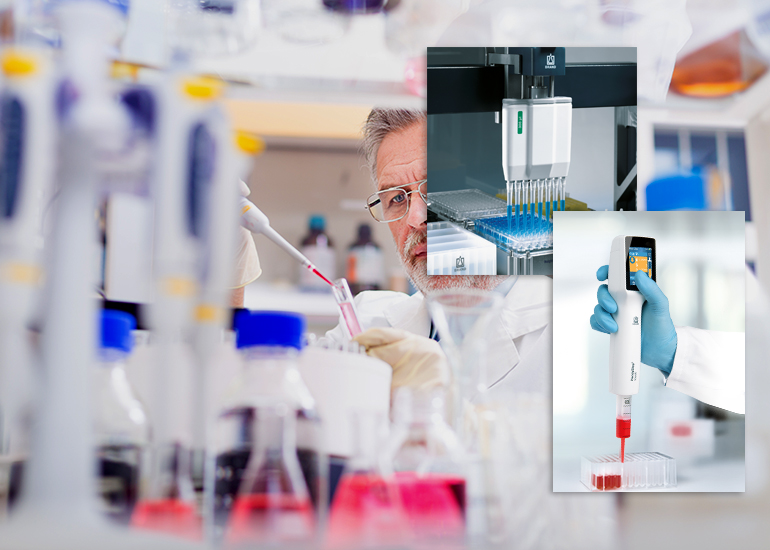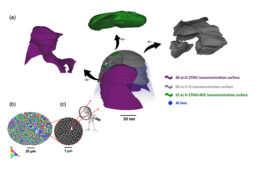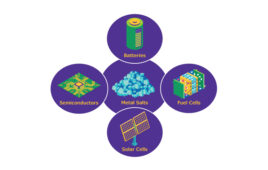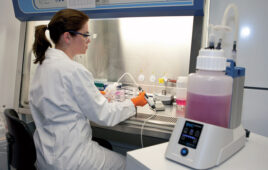
By Amy Hurtado, BRANDTECH Marketing Communications Director
In the world of laboratory research, precision and accuracy are priorities, particularly when dealing with micro- to low milliliter volumes. The success of experiments and the reliability of results hinge on the meticulous handling of liquids. A wide range of tools are available. To navigate the variety, it is essential to understand how these tools work and their suitability for specific applications. When it comes to low to medium throughput liquid handling, two primary categories of instruments are commonly used: air displacement pipettes and positive displacement pipettes.

Air Displacement Pipettes
Air displacement pipettes are used in most labs and for a wide variety of applications and are the ‘workhorse’ of the lab. As the name implies, a column of air does the actual work of moving the liquid with these instruments. The piston in the pipette moves an air column which allows liquid to be drawn into a disposable tip and then dispensed out. With an air displacement pipette, there should never be any direct contact between the liquid and the pipette or piston. If liquid is drawn into the pipette at any time, the pipette must be cleaned before further use to maintain proper performance and accuracy.
Air displacement pipettes excel when handling liquids with characteristics similar to water. With proper technique and a well-fitted tip, they offer remarkable accuracy. However, as the physical properties of the liquid deviate from those of water, such as differences in density, viscosity, or vapor pressure, the accuracy of pipetted volumes decreases.
These pipettes can be operated manually or electronically. Manual air displacement pipettes, such as the BRAND® Transferpette® S, come in both single and multichannel variations. Single channel pipettes can have fixed or adjustable volumes, spanning from 0.1 μl up to 10 mL. Multichannel manual pipettes are available as 8- or 12-channel models, with volumes ranging from 0.5 μl to 300 μl.
Electronic air displacement pipettes, offer the advantage of minimizing user-to-user variability. Electronic control of piston movements reduces the physical effort required during pipetting, making it a valuable tool for labs with medium throughput pipetting needs.

Positive Displacement Pipettes
Positive displacement pipettes differ significantly from their air displacement counterparts. They allow direct contact between the liquid and the pipette piston, offering greater accuracy when handling liquids with diverse densities, viscosities, and vapor pressures. Unlike air displacement pipettes, which require liquids similar to water in physical characteristics, positive displacement pipettes can accurately handle a wider range of liquids.
Positive displacement pipettes are particularly valuable when accurate dispensing of partial volumes is essential. For multi-dispensing of partial volumes with precision, a positive displacement pipette is the ideal tool.
The BRAND® Transferpettor™ is an example of a manual positive displacement pipette, and is available in volumes from 100 μl to 10 mL. It can be used for dispensing viscous or volatile liquids that cannot be accurately dispensed with an air displacement pipette. The tips and piston seals for the Transferpettor are reusable, and the piston seal is designed to push the liquid entirely out of the tip, minimizing carryover between samples.
A specialized version of positive displacement pipette is the repeating pipette. This is a category of positive displacement pipettes that is specifically designed to handle multi-dispensing of partial volumes accurately. The BRAND® HandyStep® S has nine step settings (1 to 5 with ½ settings) which allows for dispensing volumes ranging from 2 μl to 5 mL – depending on the size of the tip.
Electronic repeating pipettes, such as the BRAND® HandyStep® touch and touch S, offer much more versatility than manual repeating pipettes through flexibility in volume setting, more options in functionality, and touchscreen operation. With the electronic repeating pipette, it is possible to perform auto-dispensing, sequential dispensing, multi-aspirating, and even titration. Since the piston movements are electronically controlled, there is a wide range of speeds for both aspiration and dispensing, which is helpful for liquids that tend to foam or bubble. Additionally, an electronic instrument reduces strain due to repetitive motion, which can be an important consideration when performing repeat dispensing for long periods of time.

Automated Liquid Handling
When a lab’s throughput begins to increase, or for other considerations, an automated pipetting system may be the appropriate tool. Liquid handling automation differs from handheld pipetting in that it uses a robotic system to move liquid from a source to a destination. Some systems, like the BRAND® Liquid Handling Station, use air displacement liquid ends which are suitable for many types of liquids. They can compensate for liquids that would be a challenge with manually operated air displacement pipettes. The volume range for pipetting robots can range from nanoliter to milliliter volumes; and sources and destinations can range from something as small as a PCR tube or 1536-well microplate all the way up to reservoirs holding a 240 mL capacity. Automated systems are now available in a wide range of size and capacity, making robotics accessible and sensible for even low to medium throughput procedures.
Summary
When selecting the correct tool or instrument for a specific application, there are key questions that can be asked:
- What is the liquid to be transferred?
- What is the volume to be transferred?
- What is the frequency of transfer?
- What other special needs or requirements does the lab have?
In summary, the manual air displacement pipette is the workhorse of the lab. This is the ‘go-to’ instrument for most people. With volume ranges from 0.1 μl to 10 mL it can handle many tasks and a variety of liquid types. If user-to-user variability or repetitive strain are a concern, then an electronic air displacement pipette should be considered. When pipetting viscous or volatile liquids or performing accurate repeat pipetting, a positive displacement pipette is the instrument of choice. Finally, if the laboratory has increasing throughput, needs to improve repeatability, or simply wants to optimize processes, it may be time to consider automation.
MORE INFOSponsored content by BRANDTECH Scientific





Tell Us What You Think!